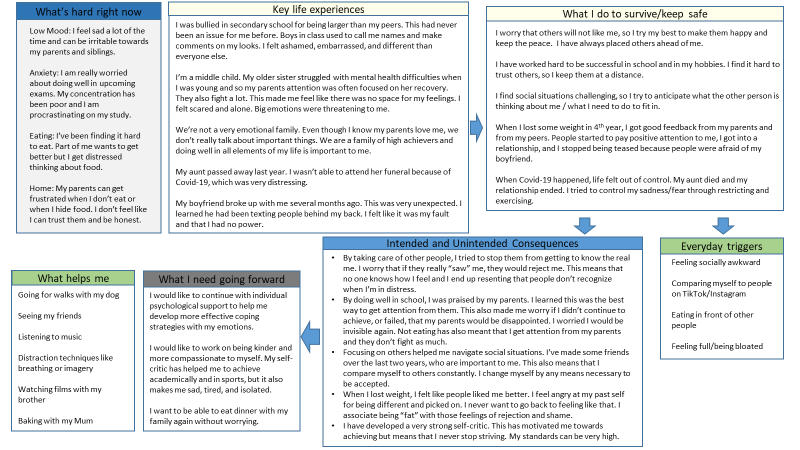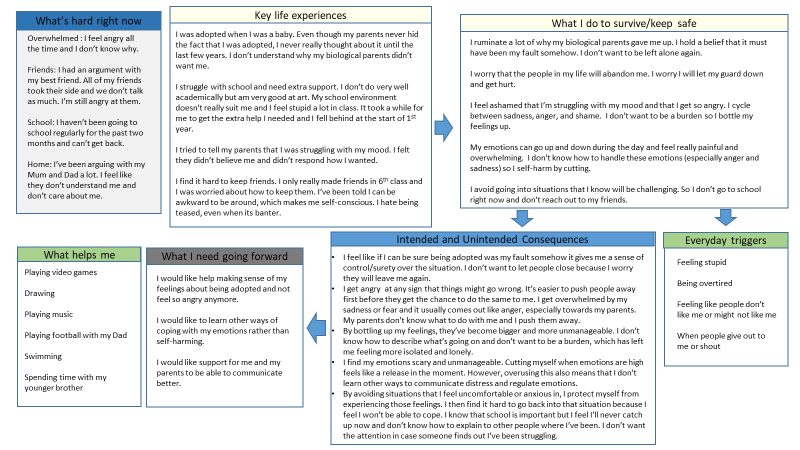What is psychological formulation?
Every individual experiences a complex and varied range of situations, events and circumstances that influences their psychological development and sense of self during their lifetime. Factors that can influence the way we view ourselves, other people and the world around us can include our experiences in relationships; our attachments; the expectations and norms of the society we are raised in; formative events in our lives; settings such as home and school, gender, culture, and age; as well as countless others.
Psychological formulation is the dynamic framework through which the connection between our individual characteristics, experiences, and behaviours can be understood.
In formulation, like creating a jigsaw, clients and clinicians work to bring together their different areas of knowledge and expertise to develop a clearer picture of a client’s experiences, challenges and current ways of coping. This sense of a collaborative experience is central to the underlying principles of formulation; the clinician offers their knowledge of psychological theory and practice, while the client brings their expert knowledge of their own lives and experiences, as well as the meaning they have made of these. The focus of a formulation is often shaped by the psychological model or intervention being used (such as cognitive behavioural therapy (CBT), compassion-focused therapy (CFT), or dialectical behaviour therapy (DBT)).
What are the benefits of psychological formulation?
-
Individuals
On an individual level, formulation has several intended helpful outcomes (British Psychological Society, 2011). Some of these benefits include:
- Explaining the development and maintenance of difficulties in a way that supports service users to view their behaviours as understandable and functional (though sometimes problematic) responses to challenging situations
- Helping the client to feel understood and seen
- Normalising problems and reducing client self-blame, stigma, and shame
- Increasing client’s sense of agency, narrative cohesion and hope.
For some individuals, the process of formulating their experiences can be a sufficient intervention in and of itself. For others, whose difficulties may require further input, a formulation can be helpful in guiding ideas for suitable interventions.
-
Families
Given that no individual exists outside of their social contexts, bringing families into the process of formulation can be very valuable. When we think about the needs and difficulties of a person, it is also important to think about how their networks and environments can either maintain or ease distress. Sharing formulations with families is also, where feasible and appropriate, very valuable.
Should service users be willing to share this more nuanced narrative understanding with their wider support networks, this can provide a framework through which their difficulties can be shared and understood with compassion. Discussing formulations openly with service users and families can help to reduce blame or guilt, as well as open new channels of communication and a different vocabulary for understanding challenges on an individual and systemic level.
-
Teams
As well as being of benefit to individuals and their families, formulation brings additional benefits to teams. In many settings, supporting individuals with mental health difficulties can require a multidisciplinary, holistic approach to address various areas and needs.
Service users in acute distress or who present as “stuck” may understandably bring up complicated emotions and reactions from team members. Understanding these reactions, and developing a team formulation, can help with the following areas (DCP, 2011):
- Helping teams, service users and carers work together
- Generating new ways of thinking about the difficulty
- Helping teams support each other with service users who present as complex or challenging
- Drawing on and valuing the expertise of all team members
- Increasing team understanding, empathy and reflectiveness
- Raising staff morale.
What can a formulation look like?
Jane (17) presented with a history of low mood, anxiety and weight loss. Following assessment, it became apparent that Jane had been engaging in significant restricting behaviours and over-exercising for the past seven months. Jane reported significant eating disordered cognitions (including a fear of losing control over eating, as well as a fear of gaining weight), as well as behaviours consistent with anorexia. A visual formulation co-created with Jane is presented below.

Daniel (15) was referred to services with a long-standing history of emotional dysregulation, difficulties with anger and self-harm. Daniel’s parents reported that, up until two years ago, he had been “their perfect child”. Daniel and his younger brother were both adopted and their parents care about them greatly and rarely set limits when they were younger. Daniel’s parents noted that, during a family tree homework assignment in sixth class, Daniel became upset at home and didn’t know how to complete it. His parents have noticed that Daniel will often become explosively angry with them, withdraw, self-harm and then will seek reassurance from his parents that they still love him. His parents are worried and confused that no matter how much they let him know they’ll never stop loving him, he continues to act out. A visual formulation co-created with Daniel is presented below.

How can formulation inform treatment?
A psychological formulation can provide a myriad of information that helps guide professionals (and service users) towards potential treatment. By identifying and getting a reasonable understanding for the processes (internal and external) that may be causing and maintaining a service user’s distress, we are more easily able to see identify possible areas of intervention. Taking both Jane and Daniel’s formulations above, we can understand both what strengths and protective factors they bring with them, as well as what they may struggle with.
Given Jane’s past experiences with bullying, shame and self-criticism, which she feels has contributed to the development of her eating disorder, she may benefit from a compassion-focused intervention such as CFT, as well as interventions to directly target her low weight and restricting. However, we can also identify from Jane's formulation factors that may interfere with her progress. She has identified that she and her family do not talk about emotional things. This difficulty in expressing her emotions may act as a barrier to Jane’s recovery. She has also identified being quite perfectionistic and has noted procrastination as a coping strategy to deal with anxiety. Jane may therefore have difficulties with completing between-session tasks, if she is worried about not doing them “well enough”. Jane has also identified positive coping strategies she is already engaging in, including going for walks with her dog in nature and connecting with friends. These behaviours can be encouraged and built upon.
Daniel’s struggles from his own perspective seem to centre mainly on emotional dysregulation and self-harm. He may benefit from a more behavioural intervention at first, such as DBT, to address his life-threatening behaviours. Daniel has identified strong fears of abandonment that has resulted in a cycle of push and pull with his parents. Daniel and his family may also benefit from a more family-based approach, such as family therapy, to address their communication difficulties, as well as Daniel’s complicated feelings about being adopted. Lastly, Daniel has noted that he is very interpersonally sensitive. This is something that would need to be navigated with care and understanding during Daniel’s intervention to ensure that should a potential rupture emerge that Daniel is encouraged to experience repair in the therapeutic relationship. Daniel has identified that he often enjoys more solitary hobbies and ways of coping, but did note positive interactions with both his Dad and younger brother. Daniel may be supported with developing more social connections, given that he has identified being isolated as having a negative effect on his mental health.
Further reading
- Understanding formulation for young people | British Psychological Society
- Guidelines on the use of psychological formulation | British Psychological Society
- Formulation in Psychology and Psychotherapy: Making sense of people’s problems | Lucy Johnstone
- Constructing Stories, Telling Tales: A Guide to Formulation in Applied Psychology | Sarah Corrie and David Lane
- Use of individual formulation in mental health practice | Lauren Cox
- Using team formulation in mental health practice | Samantha Hartley





